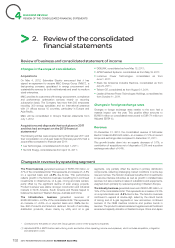APC 2012 Annual Report Download - page 146
Download and view the complete annual report
Please find page 146 of the 2012 APC annual report below. You can navigate through the pages in the report by either clicking on the pages listed below, or by using the keyword search tool below to find specific information within the annual report.
2012 REGISTRATION DOCUMENT SCHNEIDER ELECTRIC144
CORPORATE GOVERNANCE
3INTERNAL CONTROL AND RISK MANAGEMENT
Risk Solutions
The Risk Solutions Management Department defi nes and
implements principles and tools designed to manage these risks.
The network of Solution Risk Managers assesses the risks of all
major projects in conjunction with the Tender Managers during the
preparation of offers.
Risk management by the Risk and Insurance
Department
The Risk and Insurance Department contributes to the internal
control system by defi ning and deploying a Group-wide insurance
strategy, as defi ned in “Risk Factors and Insurance Strategy.” The
insurance strategy includes the identifi cation and assessment of the
main insurable risks, the determination of levels of retention and
transfer of such risks; it also defi nes and recommends measures to
prevent these risks and protect assets.
Risk management by the Safety Department
The Group’s Security Department defi nes corporate governance
with regard to loss prevention in the area of willful acts against
property and people.
In this respect and in close cooperation with the Risk and Insurance
Department, it is directly involved in assessing the nature of such risk
as well as defi ning adequate prevention and protection measures.
The Security Department publishes internally a table of “Country
Risks” for use in security procedures that are mandatory for people
travelling, expatriates and local employees. On request, it provides
support to local teams for any security issues (site audit, expatriates
or local employee security, security whilst on assignments, etc.).
It provides daily coordination with the Group’s worldwide partner in
the fi eld of medical&security assistance (International SOS - start
of contract in January2011).
It brings its methodology to develop emergency plans (evacuation
plans, crisis management plans, business continuity plans, etc.)
and ensures coordination of the corporate crisis team (SEECC -
Schneider Electric Emergency Coordination Center) each time that
it is activated.
The Security Department is integrated in the “Fraud Committee”
alongside the Internal Audit Department and the Legal Department
and gets involved in combatting internal fraud (managing and
carrying out internal investigations).
Management of information system risks
An IT Security unit within the Information, Process and Organization
Department defi nes and implements specifi c security policies for
information systems. This department has specifi c skills in auditing
the security of IT systems. After each site audit, a report is issued
setting out fi ndings and recommendations for the attention of the
persons in charge of the unit audited.
10.5 Control procedures
This section describes specifi c measures taken in2012 to improve
the Group’s control system.
Operating units
For internal control to be effective, everyone involved must
understand and continuously implement the Group’s general
guidelines and the Key Internal Controls.
Training in Key Internal Controls continued in 2012 for those
involved for the fi rst time in the annual self-evaluation process: newly
promoted managers and units recently integrated. Operational
units, trained by their line management undertook self-evaluation
of compliance with the Key Internal Controls governing their scope
of operations.
The self-assessments conducted during the 2012 campaign
covered 90% of consolidated revenues and made it possible to
defi ne improvement plans in the operating units, when necessary.
The ultimate goal is that these evaluations should cover at least
90% of consolidated revenue each year.
The self-assessments are conducted in the units by each process
manager. Practices corresponding to the Key Internal Controls
are described and performance is rated on a scale of 1 (non-
compliance) to 4 (very good).
For all responses below 3 (compliance) on the scale, an action plan
is defi ned and implemented to achieve compliance. These action
plans are listed in the self-assessment report.
The unit’s fi nancial manager conducts a critical review of the self-
assessments by process, and certifi es the quality of the overall
results. The self-evaluation is then also certifi ed by the person in
charge of the unit.
Operating Divisions
To control the reliability of the fi nancial statements and the
alignment of performance with set targets, the Group relies on
Senior Management’s quarterly review process and procedures
carried out by the Management Control and Accounting Unit to
control the quality of accounting data provided by consolidated
units (see “Internal Control organization and Management - Senior
Management” and “Internal control procedures governing the
production and processing of accounting and fi nancial information”).
In2012, the Operating Divisions continued to provide training for
the operating units on internal control issues and examined and
challenged the self-assessments of internal control of these units.
After analyzing the results, improvement plans were developed
either for certain units or for certain Key Internal Controls at the
Division level.
























